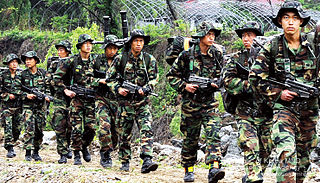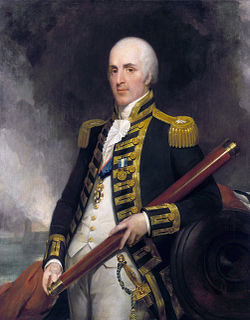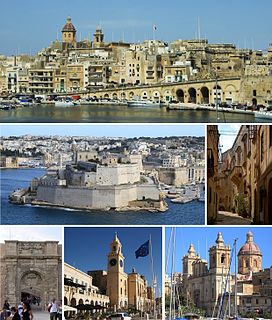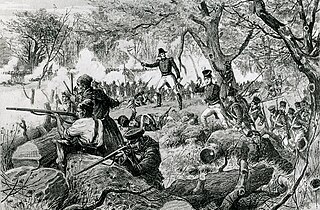| Maltese Provincial Battalions | |
|---|---|
| Active | 1802–1815 |
| Country | |
| Branch | |
| Type | Infantry |
| Size | Two battalions (1802–06) One battalion (1806–15) |
| Garrison/HQ | Fort Manoel and Fort Ricasoli, later Cottonera |
| Commanders | |
| Commanders | Colonel Marquis Paolo Parisi Conte Luigi Maria Gatto |
The Maltese Provincial Battalions were infantry battalions in the British Army which existed from 1802 to 1815 in Malta, then a British protectorate and later a colony.

Infantry is a military specialization that engages in military combat on foot, distinguished from cavalry, artillery, and tank forces. Also known as foot soldiers or infanteers, infantry traditionally relies on moving by foot between combats as well, but may also use mounts, military vehicles, or other transport. Infantry make up a large portion of all armed forces in most nations, and typically bear the largest brunt in warfare, as measured by casualties, deprivation, or physical and psychological stress.

The British Army is the principal land warfare force of the United Kingdom, a part of British Armed Forces. As of 2018, the British Army comprises just over 81,500 trained regular (full-time) personnel and just over 27,000 trained reserve (part-time) personnel.

Malta, officially known as the Republic of Malta, is a Southern European island country consisting of an archipelago in the Mediterranean Sea. It lies 80 km (50 mi) south of Italy, 284 km (176 mi) east of Tunisia, and 333 km (207 mi) north of Libya. With a population of about 475,000 over an area of 316 km2 (122 sq mi), Malta is the world's tenth smallest and fifth most densely populated country. Its capital is Valletta, which is the smallest national capital in the European Union by area at 0.8 km². The official languages are Maltese and English, with Maltese officially recognised as the national language and the only Semitic language in the European Union.
According to the Treaty of Amiens of 1802, Britain was to evacuate Malta and restore the islands to the Order of St. John. The treaty also stated that at least half of Malta's garrison had to consist of 2000 Maltese soldiers led by native officers. Although the treaty was not implemented and the British did not evacuate Malta, the garrisons were readjusted, with the existing Maltese Light Infantry, Maltese Militia and Maltese Militia Coast Artillery being disbanded. [1]

The Treaty of Amiens temporarily ended hostilities between France and the United Kingdom during the French Revolutionary Wars. It was signed in the city of Amiens on 25 March 1802 by Joseph Bonaparte and Marquess Cornwallis as a "Definitive Treaty of Peace." The consequent peace lasted only one year and was the only period of general peace in Europe between 1793 and 1814.

Malta was ruled by the Order of Saint John as a vassal state of the Kingdom of Sicily from 1530 to 1798. The islands of Malta and Gozo, as well as the city of Tripoli in modern Libya, were granted to the Order by Spanish Emperor Charles V in 1530, following the loss of Rhodes. The Ottoman Empire managed to capture Tripoli from the Order in 1551, but an attempt to take Malta in 1565 failed.
The Maltese Light Infantry was a light infantry battalion of the British Army which existed from 1800 to 1802 in Malta, then a British protectorate. It consisted of eight companies of Maltese soldiers, and it saw action in the French Revolutionary Wars. It was the second Maltese unit in British service, after the Maltese Cannoneers.
The Maltese Provincial Battalions were set up by Civil Commissioner Sir Alexander Ball in 1802 to take over the role of the Maltese Militia. The original plan was to have two infantry battalions of 1000 men each, but eventually two battalions of 700 men each were set up. In addition, two other corps were also raised at the same time: the Malta Coast Artillery and the Maltese Veterans. The 1st Provincial Battalion was headquartered at Fort Manoel, while the 2nd Provincial Battalion was based at Fort Ricasoli. The Provincials' roles included serving as a police force and a coast guard. At times, the men also repaired roads, fences and fortifications. [2]

Sir Alexander John Ball, 1st Baronet was a Rear- Admiral and Civil Commissioner of Malta. He was born in Ebworth Park, Sheepscombe, Gloucestershire. He was the fourth son of Robert and Mary (Dickinson) Ball and the younger brother of Ingram Ball.
The Malta Coast Artillery was a coastal artillery unit in the British Army which existed from 1802 to 1815 in Malta, then a British protectorate and later a colony.
The Maltese Veterans, also known as the Corps of Veterans, was a corps in the British Army which existed from 1803 to 1815 in Malta, then a British protectorate and later a colony.
According to the treaty, the battalions' officers were to be Maltese nobles appointed by the Grand Master. However, Ball himself chose two Maltese pro-British nobles, the Marquis Paolo Parisi and Conte Luigi Maria Gatto, as the commanding officers of the 1st and 2nd Battalions respectively. [2] He did not grant them commissions so as not to violate the treaty. This move was criticized by the French, and eventually the Napoleonic Wars broke out in 1803 after multiple violations of various terms of the treaty by both the British and the French. [1]

The Napoleonic Wars (1803–1815) were a series of major conflicts pitting the French Empire and its allies, led by Napoleon I, against a fluctuating array of European powers formed into various coalitions, financed and usually led by the United Kingdom. The wars stemmed from the unresolved disputes associated with the French Revolution and its resultant conflict. The wars are often categorised into five conflicts, each termed after the coalition that fought Napoleon: the Third Coalition (1805), the Fourth (1806–07), the Fifth (1809), the Sixth (1813), and the Seventh (1815).
The number of recruits in the Provincials severely depleted in 1805, when many men resigned to volunteer in the newly-established Royal Regiment of Malta. 23 men of the 2nd Provincials died in a gunpowder magazine explosion in Birgu on 18 July 1806. What remained of the two battalions were merged into a single battalion based at Fort Manoel and commanded by Parisi in October 1806. [2] Since the men had agreed to a maximum of five years of service, there were plans to disband the Provincials. However, Ball was against this and the terms of service were renewed in 1807 and again in 1812. [1] Parisi resigned his commission in 1811, and he was succeeded by the Conte Luigi Maria Gatto, former commander of the 2nd Battalion. By the following year, the unit was based at Cottonera. [2]
The Royal Regiment of Malta was an infantry regiment in the British Army which existed from 1804 to 1811. It was raised in Malta, then a British protectorate, with the intention of being sent in overseas expeditions. The unit was raised following the success of the Maltese Light Infantry at the Siege of Porto Ferrajo in 1801.

The Birgu polverista explosion was the accidental detonation of ammunition in the gunpowder magazine (polverista) of Birgu in the British Malta Protectorate on 18 July 1806. The explosion occurred due to negligence while transferring shells from the magazine, and it resulted in the detonation of 40,000 lb (18,000 kg) of gunpowder. It killed approximately 200 people, including British and Maltese military personnel and Maltese civilians from Birgu. Parts of the city's fortifications, some naval stores, and many houses were destroyed, and the affected area became known as l-Imġarraf.

Birgu, also known by its title Città Vittoriosa, is an old fortified city on the south side of the Grand Harbour in the South Eastern Region of Malta. The city occupies a promontory of land with Fort Saint Angelo at its head and the city of Cospicua at its base. Birgu is ideally situated for safe anchorage, and over time it has developed a very long history with maritime, mercantile and military activities.
During the Maltese plague of 1813–14 , the Provincial Battalion assisted the civil authorities in trying to contain the outbreak. This led to a drastic decrease in the number of new recruits, who did not want to risk getting infected themselves. The battalion's reduction and disbandment was seen as inevitable by late 1813. [1] By 1815, the unit consisted of four companies. [2]
The Maltese Provincial Battalions were amalgamated with the Coast Artillery and the Veterans to form the Royal Malta Fencible Regiment on 16 February 1815. [3]




